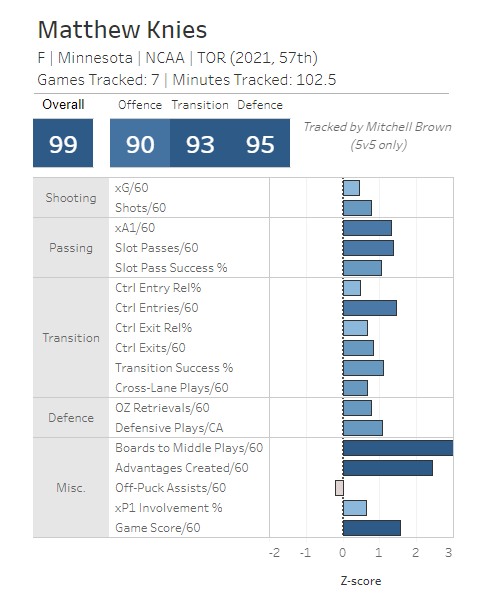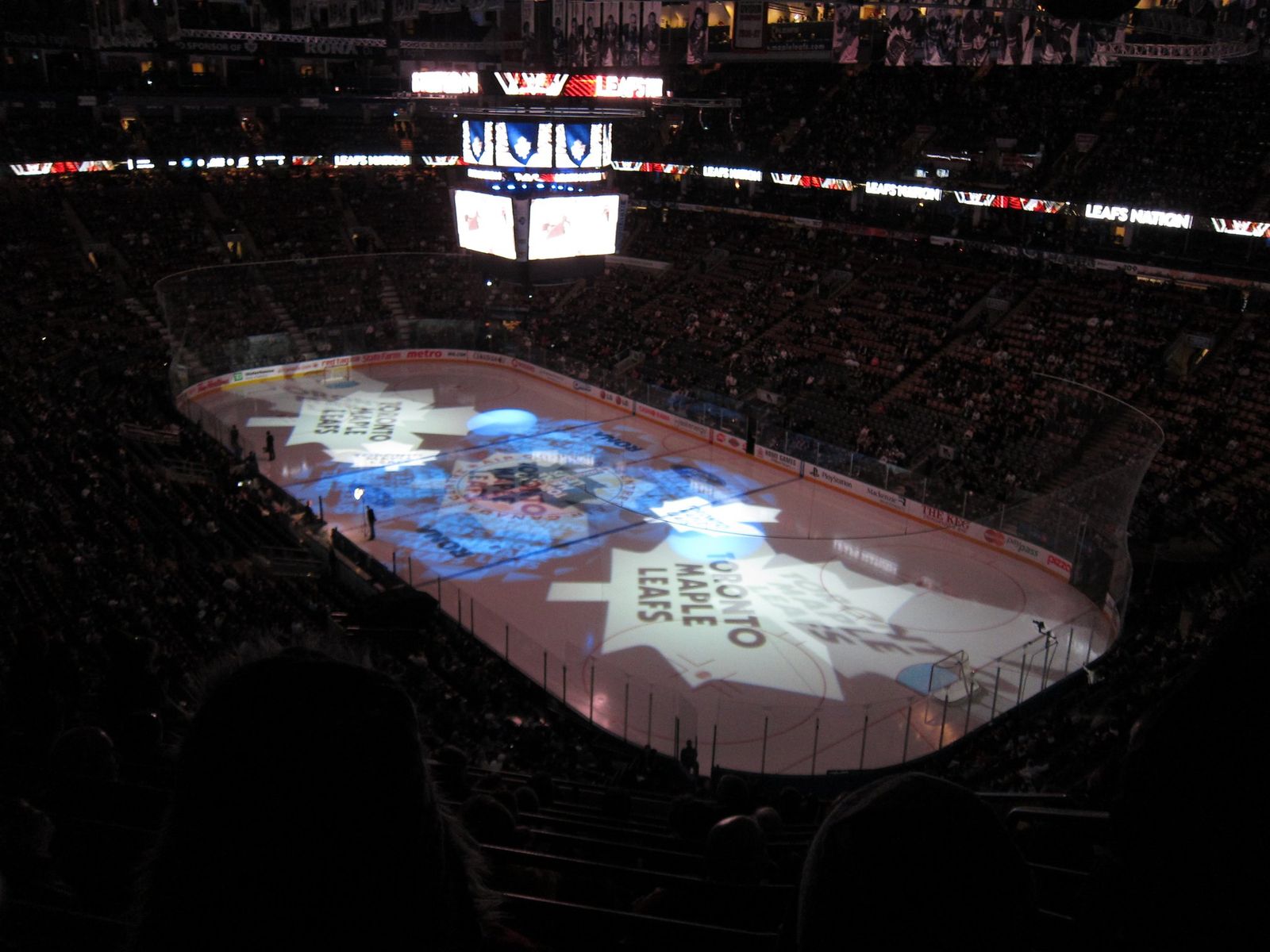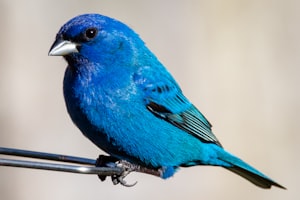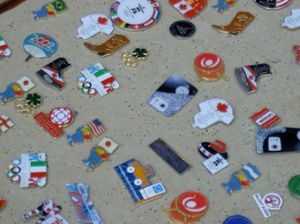A while back I was listening to an episode of the PDOcast, hosted by Dimitri Filipovic. I don't normally listen to this podcast, but he had Mitch Brown from Elite Prospects on as a guest to answer questions from his listeners. There was one question and answer in particular that was very interesting to me, because he specifically mentioned Matthew Knies at the end of it.
Here's a link to the full episode on Spotify, and I will quote snippets of Brown's answer to this question throughout the article. I want to take everything Mitch Brown said above and use it as a launching pad talk about Matthew Knies' NHL-readiness. More specifically, I want to look at what things Knies does well that could indicate that he's ready to have an impact in the NHL right now. And I want to use Brown's quotes above as the basis of what things can a prospect do really well that are valuable as a pro.
And we'll start with the part in which he specifically cited Knies as an example.
Board Play
So let's start with what Mitch Brown identifies as the most important skill juniors can show that translates to the pro level:
Probably the most important one at this stage is board skills. So this kind of ties in – this is cheating, right, because being good along the boards has so many different components. I feel kind of bad saying it, but I think we framed board skills in the wrong way for too long. Being big as the attacking player along the boards is usually more of a weakness than a strength. It's about leverage, being able to get your hips lower than the opponents.
So, Seth Jarvis is a great example of this, but if you're not familiar with Seth Jarvis, listeners, then Nathan MacKinnon – think Nathan MacKinnon along the boards, or Sidney Crosby. They win the body positioning race when they're skating for a loose puck or whatever. That means they get their leg in front of the opponents, then they skate through their hands, then they make pre-emptive contact with a reverse hit. Or if you're Seth Jarvis, you just beat the guy in the ribs until he backs off a little bit.
To do that you need to be strong, but you also need to be able to skate. You need to be able to drop your hips, right? Get low. That's a product of ankle flexion. And you also need to be able to escape off your outside edges. So with pressure on your back, these guys – Jarvis, Mackinnon – they work the boards for as little as possible.
Again, just like what we were saying with [Jason] Robertson. If there's a tiny bit of space, they will put that puck underneath the opponent's stick, skate straight through their hands and attack the middle. If not, they'll wait for the defender to close space again, then cut back with that punch turn again that we talked about earlier, slingshotting themselves around that turning leg and then attacking space again.
And the puck is always positioned to make the next play. The hands, there's no overhandling the puck. It's just quick and simple touches where it needs to be. So in a few seconds – this is all happening super quickly, right? You have to be able to skate, handle the puck, absorb and play inside contact, anticipate openings and then dictate the actions of opponents at a high level with your feet moving, and your head up. If a player is short on just one of those, their board play fails more often than not in the NHL.
So like, having that ability alongside that aggressive mentality is huge. There are some prospects for whom it's a huge part of their game. Matthew Knies, Toronto Maple Leafs prospect – this is his game. Everything that he does is getting the puck off the wall and attacking the middle.
So Mitch already spoiled this part, but arguably the most impactful thing in Matthew Knies' game as a potential pro is his board play. In the NCAA, he's really, really good at it.

If you want more info straight from Mitch Brown on this, he covers a lot of it in his great breakdown video of Knies during last year's NCAA season:
So this was something that Knies was already good at last season, but it also something he continued to work on improving this season.
From The Athletic (bold for emphasis by me):
His relationship with the Leafs remains strong. He knows his skating, particularly his east-west movement, needs to improve. He said members of the Leafs development staff will often listen more than they speak, eager to hear about how he’s filling in the “little holes.” Lately, a focus of Knies’ has been improving how quickly he can win pucks along the wall and then send them to the right areas of the ice, for example.
Basically, when the puck is along the boards, there's a good chance that Knies will a) come away with it, and b) immediately get the puck to the middle of the ice where any shots or scoring chances are more dangerous.
Knies being good at board play is not just because he's big, strong, will outmuscle smaller players for the puck, and be a big meanie. I mean, he will do all that, but it's how he does it that matters here, plus what he can do after he does all that.
He just gets the puck. This starts when he engages physically with the other player trying to get it first. He goes to the boards in a race with another player, and establishes body positioning. He gets low, and puts his body between the other player and the puck. He'll often use his leg as a barricade. When the defender makes contact, Knies absorbs the contact and spins away to create space, and at that point they're looking at his back and have no way to get the puck off him.
In all the clips below, Knies is #89.
And I HAVE to share this clip on its own.
Name someone more fun to watch forecheck than Matt Knies.
— More like Nikita GREATbyonkin (@brigstew86) November 5, 2022
I'll wait.
Speed to get to the puck. Size and physicality to terrify defenders. Skill to come away with it and make a no look backhand pass for the assist.pic.twitter.com/fNlPKtDm30
If the other player gets it first, Knies is a relentless puck hound and capable puck thief. He will reach from behind the puck carrier and lift their stick, then sweep the puck away to carry/pass it to a more advantageous area. When Knies gets possession of the puck in this scenario, he will most often try and get it to the middle of the ice immediately. He'll cut to the middle, try and dangle past a defender if he can or pass it to a teammate in the middle.
Knies has enough skill to make you ooh and aah now and then, but it's not a consistent thing – especially his passing. But he pulls off some nifty mittens skill plays often enough in the NCAA to be very, very effective at creating offense for his teammates.
This makes him very effective on the cycle, in a way that is really impactful. He's not just constantly carrying and passing it along the boards and getting it to the point. That's safe and boring and not very dangerous. What Knies does in the NCAA is get the puck off the boards and create something actually dangerous.
Transitions
Here's what Mitch Brown said about the importance of making lateral plays on transitions:
The first one, probably, is something like lateral transition passing and puck carrying. That means skating towards pressure, not skating away from it – draw in the pressure, then passing through to an open teammate or setting up a one on one move with inside crossovers. It's space creation 101. You're trying to bring an opposing player towards you to create more space for where the puck eventually goes.
The average NHL team crosses the dot lane – outside to inside, inside to outside, cross ice, whatever, so just lateral movement – on something like 25% of their entries or exits. That's literally just in the action that gets the puck across either blueline. In junior it's half of that. And at both levels cross lane plays result in more scoring chances.
Here we see a similar effort by Knies to get the puck to dangerous areas as we did with his board play. He will carry the puck at defenders to try and entice them to make some kind of move at him – reaching with their stick, stepping up to try and throw a hit, and so on. Knies seems to wait for this, and then will typically do one of these things:
- Cut or deke around and past the defender.
- Dump the puck by flipping it past, dodging the defender and using his advantage in forward speed to get to it first.
- Pass it to a teammate in a more dangerous area.
And here are some examples of Knies (#89) doing these very things:
Puck protection
The final point that Mitch Brown makes is on delay game, but touches on how it relates to puck protection in an important way:
And then a solution to that, is a delay game. All players of all skating ability, from Connor McDavid to Alexei Protas – don't know if Protas was gonna be, anyone have that on their bingo card for today, but I respect his game a lot – they find space by cutting back or cutting inside off the rush, they sprint and then they decelerate really fast to create a gap between them and the defender in front of them. The basic idea is inverting pressure.
So the best position for you as the attacker to be in relative to a defender is having the defender behind you. If you can outskate them to the net, get them on your back, that's favorable because you can drive. If you can't do that, you cut back, you slow down, that puts the pressure behind you. And from there you can find a trailer and so on.
This is something that Knies has worked on more this season, that we didn't really see last year. Knies generally didn't do much in the way of delays, he was a very high octane and constantly moving at top speed, skating through brick walls kinda guy. He wanted to make skill plays at high speed. But adding this delay and cut back is something that helps him because one of his biggest strengths is having the defender on his back and blocking them from even trying to get the puck. This is still something that he could stand to do more often, but he has improved.
Play around the net
There are two other ways that Mitch Brown did not talk about, but that I think are still worth mentioning when it comes to talking about Knies' potential in the NHL. The first is his play around the net, and his ability to score goals, cause chaos, and/or create scoring chances in front for himself or his teammates in close.
While Knies may not be the most dynamic puck carrier, he is very effective stick handling in tight spaces. That's where he can pull off his best dekes. His passing is also best when it's shorter distances and in crowds, as he can make some pretty creative and deft plays through his legs and from behind the net. He's also gotten better at finding soft spots in front of the net, so he can get open for a better shot.
Again, Knies is #89 in all these clips below:
The new element to his net-front game that he's added this season is deflecting the puck. He's had a few goals coming off some kind of deflection, showing a deft touch on both shots and shot-passes. Here are some examples:
Penalty killing
Lastly, the other area where Knies has potential as a pro is on the penalty kill. He has good size and reach, plus above average skating so he can cover a lot of ground. He's got a good stick to help him break up passes, either as clean interceptions or just knocking it away. He is also good along the boards to lift sticks, steal pucks, and physically pressure puck carriers to create turnovers.
He is also a scoring threat on the penalty kill, generating a fair amount of chances or at least killing time by creating rush chances deep in the other team's end. Here's two of his short handed goals from this season.
Do I think that Matthew Knies is NHL ready right now?
Do I think that, right now, the Leafs could plop him into their lineup and he'd be one of the 12 best options at forward for their late season and playoff roster? If I were a betting man? No. I wouldn't put money down on that if you put a gun to my head.
While I don't think there is a 0% chance of it, and I think all of the above skills and strengths I have talked about are great examples of what will help him ultimately succeed in the NHL for his career... I don't think it means he can be an impact forward right now. Play a depth role on the fourth line and tread water? Sure. But I don't really count that as being "NHL ready". If I were to bet, I'd say he's capable of being replacement level depth right now.
Because the jump from the NCAA to the NHL is no joke. If we're talking about right now, with only a few games left in the NHL season where he has to acclimatize to a new team, new teammates, and new systems? On top of a very large jump in the quality of competition? That's asking for a lot.
You may have noticed that throughout the article I kept adding the qualifier: "...in the NCAA". In the NCAA, he has elite skills. But he's not going to be at an elite level in the NHL, not right away. NHL competition is much bigger, faster, more skilled, better defensively, better at goaltending, and play in much better defensive systems.
And what you don't see in all the highlights I shared are the lowlights. Senseless turnovers because he tried a between-the-legs, no-look pass when surrounded by three defenders. Trying to go one on four on a rush and turning it over at their blueline. Open passes that he just missed, because passing is likely the weakest element of his offensive game. Those are all things you can already notice in the NCAA. He can get away with it more often than not in the NCAA because he's much better than the competition most of the time. But in the NHL he won't be, and he's going to need to adjust and learn to be safe but effective while knowing when he can and should go for the skill play.
In a magical fairy tale world where Toronto goes on a deep playoff run, there will be injuries. There will be guys whose play goes into a funk. There will be times Keefe may be more willing (read: desperate) to inject some 'energy' into the lineup, and at that point Knies will have been spending more time adjusting to his teammates and Keefe's system. I can guess that on a deep playoff run, Knies gets into some game action. I can see Knies being able to hold his own in a fourth line role. Keep his game simple, and use the best tools in his toolbox: be big, be strong, forecheck hard, cause chaos on the cycle, be a nuisance in front of the net. I think he can do that all in the NHL right now.
And beyond this year, I think Knies is going to become a fan favourite. Likely not an All-Star, not a 30 goal/point-per-game guy unless he really does become the next Zach Hyman, but the kind of support player that works well in the top six doing the dirty work for the stars. Someone in the mold of Zach Hyman, Michael Bunting, Alex Kerfoot, Calle Järnkrok, and so on. Because Knies can do a bit of what they all do. He has some of Hyman's forechecking and board play. Bunting's shot and net front play. Kerfoot and Jarnkrok's smart two-way play.
I just wouldn't bet on him to do that all at an NHL level right now.






